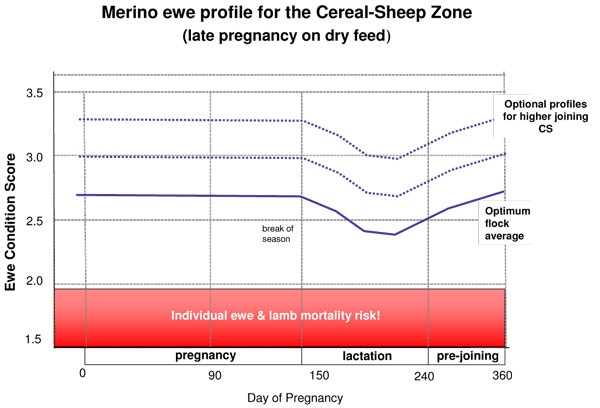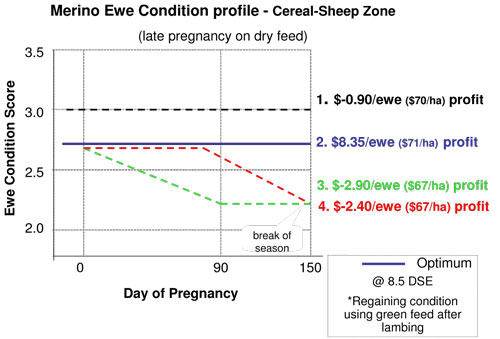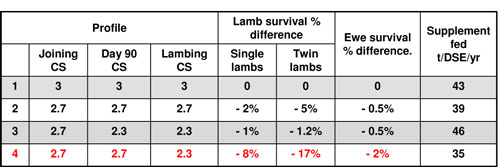|
Cereal-Sheep
Zone
(WA, SA,
Vic)

The optimum
profile for May
lambing flocks
in the
Cereal-Sheep
Zone (Figure 1)
is:
a. maintain
ewe condition
from joining to
lambing and
regain condition
in
lactation
b. aim
for Condition
Score 2.7 or
higher at
joining
c. ewes
require good
feed during
lactation to
ensure high lamb
growth rates
The most
important target
for ewe flocks
is to maintain
condition until
lambing
commences,
meeting this
target gives the
optimum
profitability.
The analysis
conducted by
lifetimewool
balances the
cost of
supplementary
feed, the likely
pasture
availability,
the changes in
stocking rate,
the effect of
nutrition on
reproduction
rate, lamb and
ewe survival,
ewe wool
production and
progeny growth
rates and wool
production to
determine the
optimum profile
for ewe
management over
pregnancy.

Key Points
- Ewes being mated in November are usually close to peak condition score (CS) or are rising in condition score during mating. This ensures that a high reproductive rate is achieved and overcomes some of the losses due to mating outside of the natural breeding season.
- The break of season is usually close to lambing and paddocks should be deferred until a feed wedge is grown (at least 700 FOO with the optimum 1500 FOO in lactation).
- Condition at lambing is a key target as this affects lamb and ewe survival. It is not recommended any breeding ewe is in CS 2 or lower as there are significant mortalities of ewes and lambs particularly twins.
- Ewes in early lactation will tend to lose condition as any available energy is channelled into milk production. Higher pasture FOO gives high lamb growth rates.
Supplementary feeding through Autumn to maintain condition is the most profitable management option.
Maintaining condition, compared to gaining condition, gives the most efficient conversion of feed. It is important then to not allow any loss of condition if it needs to be re-gained prior to lambing using grain. Although feed costs are high, losing condition or having too low a condition by lambing will also decrease the survival of lambs and increase the mortality of ewes during lambing, thereby affecting profit and production.

Figure 2.
Profile 1. Profit is similar to the optimum but requires a lower stocking rate (0.5 DSE).
Profile 2.Optimum due to maintenance feeding in pregnancy and regaining condition on green feed in lactation.
Profile 3. Profit is lower due to the loss of production and lower survival caused by low condition prior to lambing and the cost of grain feeding in early pregnancy.
Profile 4. Ewe and lamb mortality limits profitability through lamb and ewe survival as well as lifetime wool production of the progeny.
Trade-offs of risk for profit
The optimum profile shown in Figure 1. takes into account both profitability and the health of the ewe flock. The other profiles, shown in Figure 2, offer only small differences in profitability but there are some important trade-offs in production to consider if following these profiles.
Ewe mortality generally increases with lower ewe condition by lambing (although there are other factors that influence this, such as weather, age and available feed). Ewe condition in late pregnancy has a large impact on lamb birth weight and therefore lamb survival. Twin lambs are more sensitive to this change in birth weight (& survival) as their birthweight is usually lower than the optimum. Table 1 shows the effect of several profiles on both lamb and ewe survival.

Table 1. Difference in survival of ewes and lambs for late lambing flocks compared to maintaining condition score 3 throughout pregnancy in the Cereal-Sheep Zone.
Following a lower profile (profile 4) to the optimum (profile 2) at lambing means that by lambing the flock average will be CS 2.2 with a significant proportion of the mob below the recommended CS 2 minimum. This leads to severe penalties in ewe and lamb mortality. Profile 4 in Table 1 shows that twin lambs have a predicted decrease in survival of 17% compared to maintaining in CS 3 throughout. This can be compared to the optimum profile which has a decrease in twin lamb survival of 5%.
Following the lower profile has no room for getting it wrong or provides no buffer in poor lambing conditions.
Running Lower Stocking Rates
Producers may choose to run flocks at stocking rates lower than are recommended for maximum profitability. There are many legitimate reasons for doing this, including fitting around changing crop rotations, however, for producers who wish to improve profitability, ewes per hectare are the biggest driver of profitability. By following the lifetimewool ewe profile, you can identify opportunities to lift stocking rate safely during periods where CS targets are being met easily.
In years that ewes' peak condition prior to joining is above the recommended target due to a great season or flock restructuring, it is worthwhile following the same trend of maintaining condition score from joining to lambing for that season rather than trying to drop condition to a lower profile. Continuing to run ewes at this higher flock condition score year in year out will give a slightly lower profitability to running ewes at the optimum profile, as the higher production gains are offset by the higher cost of supplementation.
Download full MIDAS analysis (250kB pdf)
Or choose the general topic required :
How whole farm profit is affected by the condition of ewes
Improving ewe fleece weight and wool quality
Ewes in better condition at joining conceive more lambs
Improving lamb survival
More productive lambs through better ewe management
Managing twinning ewes for higher production
Managing ewe mortality
or download/ request a hard copy of the Ewe Management Handbook for the Cereal-Sheep Zone
Tools including Pasture photos, condition scoring and feed budgeting
Back to Top
|